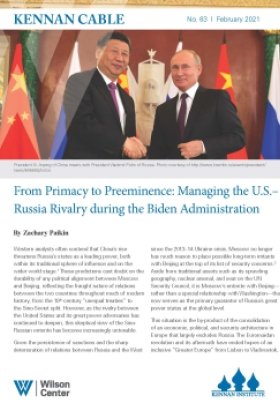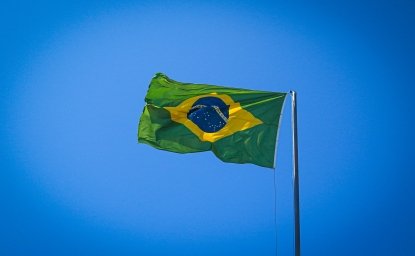Kennan Cable No. 63: From Primacy to Preeminence: Managing the U.S.-Russia Rivalry during the Biden Administration


Western analysts often contend that China’s rise threatens Russia’s status as a leading power, both within its traditional sphere of influence and on the wider world stage.[i] These predictions cast doubt on the durability of any political alignment between Moscow and Beijing, reflecting the fraught nature of relations between the two countries throughout much of modern history, from the 19th-century “unequal treaties” to the Sino-Soviet split. However, as the rivalry between the United States and its great power adversaries has continued to deepen, this skeptical view of the Sino-Russian entente has become increasingly untenable.
Given the persistence of sanctions and the sharp deterioration of relations between Russia and the West since the 2013–14 Ukraine crisis, Moscow no longer has much reason to place possible long-term irritants with Beijing at the top of its list of security concerns.[ii] Aside from traditional assets such as its sprawling geography, nuclear arsenal, and seat on the UN Security Council, it is Moscow’s entente with Beijing—rather than a special relationship with Washington—that now serves as the primary guarantor of Russia’s great power status at the global level.
This situation is the by-product of the consolidation of an economic, political, and security architecture in Europe that largely excludes Russia. The Euromaidan revolution and its aftermath have ended hopes of an inclusive “Greater Europe” from Lisbon to Vladivostok, or even a long-term arrangement suitable to all parties in the absence of a full-fledged shared security system. Taking their place is an American-led “active pressure campaign” against Russia with no clear endgame.[iii] This leaves Moscow with little incentive to show restraint for fear of being made subject to further demands.
While all sides have contributed to this state of affairs, the posture of global primacy that has guided U.S. foreign policy throughout the post-Cold War era has been the main driver of growing security competition between the world’s most powerful states. Jennifer Lind and Daryl G. Press describe this drive for primacy, which goes beyond the mere preservation of American preeminence, as being rooted in “disregard for the core interests of potential adversaries.”[iv] This has not only pushed Russia and China closer together, but also exposed some of the contradictions of the so-called liberal international order. With any fundamental reset between Washington and Moscow unlikely for the foreseeable future, the limited but complex task of the Biden administration will be to shift the current primacy-oriented pressure campaign against Russia toward a more sustainable—yet still adversarial—relationship based on deterrence.
W(h)ither the liberal order?
In Western policy circles, events such as Russia’s annexation of Crimea and the election of Donald Trump are reflexively considered to be threats to the “liberal international order” (LIO). However, beyond the fact that this term did not come into regular usage until decades after the order’s supposed creation in the wake of World War II, the nature and scope of the LIO are often taken for granted. Besides a generic commitment to “rules-based” interaction among states, many of the principles that are said to underpin the LIO rest on dubious intellectual ground, challenging the notion that it should be considered synonymous with world order writ large.
For instance, the notion that the LIO rests upon a commitment to free trade is challenged by the reality that many countries—including liberal democracies—embraced protectionist policies long before Trump’s arrival in the White House. Nor is the advent of increasingly liberalized global trade necessarily a product of an overarching and enduring LIO. As Robert D. Kaplan has noted, “globalization was never a conflict-free security order, as originally advertised, but merely a value-neutral, temporary stage of economic development.”[v]
An additional feature of the liberal order—U.S. or Western leadership—has not been recognized as legitimate by other powers. What Moscow considers to be a mere “system built around American unipolarity” is not akin to the entrenchment of a universal LIO.[vi] Similar to the early Bolshevik period in which Russia adopted a revolutionary rather than a defensive mindset, Russian attempts to liberalize and join the West in the early 1990s were more reflective of a brief turn in European and global history than a permanent shift in Russian strategic attitudes.
Proponents of liberal internationalism also claim that their policies are aimed at protecting the right of small states to determine their own security arrangements. However, the factors that have buttressed the independence of small states in the postwar era—universal sovereignty, inviolable state borders, and sustained U.S. naval dominance—appear to conflict with more established liberal principles such as international integration, national self-determination, and security interdependence. This highlights how efforts to actualize and defend a “liberal” order can be fraught with confusion, leaving Western foreign policy vulnerable to accusations of double standards.
According to Richard Sakwa, these inconsistencies serve to highlight a core contradiction of the LIO that has become evident with the return of great power rivalry, in that it nominally embodies a universal “values order” even though it is upheld by a “power system” based on Western hegemony.[vii] Behind the inconsistently applied goal of spreading liberal values and norms rests a pursuit of American global primacy that has remained constant for the past three decades. Moscow and Beijing perceive this U.S. posture as a threat not only to their security but also to their status as equal great powers in the international system. The fact that American relations with Russia and China have continued to worsen over the past four years shows the extent to which the Trump administration did not fundamentally deviate from this approach, despite the concerns that were regularly voiced over the future of U.S. leadership. However, while Washington’s post-Cold War strategic posture has helped to push Moscow and Beijing closer together, it is not the only source of the deepening Sino-Russian strategic partnership.
Russia-China relations and global order
Since the initial aftermath of the Ukraine crisis, Russian foreign policy has been marked by its burgeoning “Greater Eurasia” vision, underwritten to a significant extent by its deepening entente with China. However, Russia’s announcement of its “pivot to the east” preceded the Euromaidan revolution by several years—a manifestation of Asia’s increasing strategic importance and dynamism and not just the troubled character of Moscow’s relations with the West.[viii] While it is true that Yevgeny Primakov’s tenure as foreign minister in the late 1990s emphasized the idea of a partnership with China and India to balance against the West, even his more liberal predecessor Andrei Kozyrev maintained that Russia should not choose definitively between East and West.[ix] This bicontinental discourse plays an important role in Russian politics and foreign policy, simultaneously reinforcing the country’s sense of national uniqueness, great power status, and special responsibility to uphold international security.
The process of normalization between Moscow and Beijing after the Sino-Soviet split began in the mid-to-late 1980s, long before Washington settled into an apparent strategy of “dual containment” of Russia and China beginning in the late Obama years.[x] In the context of the U.S.-Russia-China strategic triangle, Moscow has a natural interest in fostering good relations with Beijing irrespective of Washington’s posture, particularly given the lengthy border that the two countries share. If the factors driving Sino-Russian cooperation inherently produce a sustained confrontation with the U.S., then this perhaps says more about the nature of post-Cold War American foreign policy than it does about Russian or Chinese aims.
It is true that Russia and China do not possess identical conceptions of international order and that they have experienced the post-Cold War world differently. While Russia emerged from the Cold War no longer a superpower, China has been a beneficiary of existing international arrangements that have allowed it to mount an impressive economic rise.[xi] Moreover, while Moscow pursues a vision of a “polycentric world” as an end in itself to guarantee its place at the table of great powers, China is primarily preoccupied with preserving the international conditions that allow it to continue its economic modernization.[xii] Taken together, these differences paint Russian aims as more disruptive and Chinese goals as more pragmatic.
However, despite these differences, Michael Kofman asserts that the two countries have achieved “deconfliction [with each other] at the strategic level,”[xiii] facilitating their ability to “secure their strategic rear” in their respective contests with the U.S.[xiv] Security cooperation and trust building remain important features of the Russia-China relationship, both bilaterally and within regional bodies such as the Shanghai Cooperation Organisation. Unlike relations between the member states of the European Union, Sino-Russian ties are not entirely “de-securitized” or free of strategic considerations. Nonetheless, two powers that feature different political systems, dissimilar worldviews, and a history of mutual antagonism have managed to forge an entente rooted in substantial foreign policy coordination. This challenges the notion that a stable international order must be based upon a single set of norms and universal values.
Despite Moscow’s overriding goal of remaining an independent great power, Russia and China have proven able to compartmentalize areas of friction that would otherwise threaten to impede cooperation between them. Beijing’s rising profile in Europe and its neutrality in the Russia-Ukraine conflict—both products of China’s Belt and Road Initiative—have failed to impede the deepening of the Sino-Russian strategic partnership at the global level. In the Asia-Pacific theatre, Russia maintains good relations with Japan, India and Vietnam to avoid excessive dependence on China, but Moscow’s limited aims in the region do not threaten Beijing. In Central Asia, while no formal division of labor between the two countries exists, Russia and China have found a way to share power in a fashion that has thus far assuaged Russian concerns over its relative decline. In all cases, shared animosity towards Washington outweighs the potential divergence of interests in each other’s “backyards.”
In short, Moscow and Beijing have managed to develop a stable relationship as equal great powers on the basis of minimalism, an approach to international affairs in which robust institutions, military interoperability, and a shared values discourse are not the primary means through which cooperative relations are sustained. This contrasts markedly with Washington’s approach to order-building, which—even if one ignores its push for a global order rooted in liberal values—hinges on formal alliances where the U.S. is unquestionably the senior partner. Proponents of the LIO may take solace in the fact that, despite their shared opposition to U.S. hegemony and interventionism, Russia and China have yet to advance a comprehensive alternative vision for world order.[xv] However, this perspective ultimately misses the fact that the Sino-Russian approach does indeed provide an alternative model for stable great power relations.
In contrast with the Sino-Russian model, conceptions of international order rooted in U.S. leadership rest on more rigorous and inflexible principles. Countries such as Poland, Hungary, Turkey, India, and the Philippines have been periodically derided for being led by illiberal strongmen and at other times sought after to join an alliance of democracies to contain Russian or Chinese ambitions.[xvi] The former tendency favors the stringent application of liberal values on the world stage, while the latter aims to preserve the primacy of U.S.-backed norms by relegating non-democracies to second-tier status in the international order. Neither vision is compatible with a world order rooted in ideological pluralism. Perhaps the central question concerning great power relations and world order over the coming years concerns whether the West, and particularly the U.S., can ever accept minimalism as a legitimate means of solving global problems and ordering interstate relations. This calls into question the nature—and perhaps even the very notion—of U.S. leadership.
U.S.-Russia relations under the Biden administration
According to Bobo Lo, had Donald Trump been elected to a second term and the transatlantic community suffered a potentially fatal blow, Moscow could have moved toward a foreign policy centered less on a critique of the LIO and focused “more directly on Russia’s great power relations with the United States and China, either individually or in a quasi-Yalta arrangement.”[xvii] Joe Biden’s election likely ensures the continuation of a more explicit normative confrontation between Washington and Moscow featuring different visions of world order: universal values versus respect for pluralism, U.S.-centrism versus polycentrism. And while the worsening of U.S.-China ties may offer Moscow some space for maneuver in its relations with Beijing, the persistence of Western sanctions and the consolidation of Europe’s security order against Russian interests preclude any fundamental reconciliation between Russia and the West. These trends suggest that the fundamentals of the Sino-Russian entente remain strong.
The Russo-American confrontation is therefore likely to continue for the foreseeable future, especially given the power asymmetry between the two countries. Nonetheless, it can and should be brought to rest on more stable ground.
This task will prove challenging. Although the need for the Biden administration to focus on deep domestic challenges could produce more limited foreign policy aims, an inward-looking America may also not be amenable to revisiting the core tenets of its global role. Moreover, policy circles in Moscow have increasingly come to view the European Union as representing little more than an extension of American power. This damages prospects for dialogue between Brussels and Moscow to serve as a means of enhancing the EU’s strategic autonomy, which could help to transform Europe into a stabilizing buffer of sorts between the U.S. and Russia. In this context, Russia is likely to continue its (counterproductive) efforts to sow divisions in the transatlantic alliance and play on elements of discord within Western societies.
The events of recent years have left Russia and the U.S. locked in a zero-sum struggle. Mainstream analysts and politicians inside the Beltway view the absence of American leadership as tantamount to international disorder—in other words, threats to American primacy imperil American security. Meanwhile, the consolidation of an exclusionary Euro-Atlantic regional order has encouraged Moscow to securitize its relationship with the West both internationally and domestically, with threats to the regime viewed as wholesale challenges to Russian state security. In this context, Western economic, diplomatic, and military policies aimed at changing Moscow’s external behavior do not produce their desired effect.
The Kremlin will likely view the Biden administration as embodying the “last gasp of the former liberal consensus,”[xviii] with competition rendered more predictable but also more acute by the election of a president with greater freedom to set U.S. policy toward Russia. For its part, the U.S.—having failed to incorporate Russia into the West after the Cold War—is left with few policy options besides hoping for either regime change or Russia’s gradual disappearance as a significant power. This leaves neither side prone to compromise, particularly given that Russian President Vladimir Putin will need to determine his political future during the Biden presidency before his term expires in 2024.
Yet the notion—common in Washington policy circles—that the alternative to American global leadership is a world rooted in spheres of influence is misleading. Perhaps counterintuitively, while great powers retain a significant capacity to determine the context of the global policy agenda, their ability to exert themselves at the regional level in a world of universal sovereign statehood is more mixed. In particular, Russia’s influence in the post-Soviet space stands at an uncertain juncture: Ukraine and Moldova now lean toward the West, protests in Belarus have rendered Moscow’s long-term relations with its closest post-Soviet partner unclear, Turkey’s presence in the South Caucasus is on the rise even as the Nagorno-Karabakh settlement has called Russia’s alliance with Armenia into question, and China’s role in Central Asia continues to grow.[xix] For its part, China also faces an unfavorable security environment as its increasingly assertive posture has triggered a backlash from states within Asia and beyond.[xx]
A concerted effort by the Biden administration to re-establish the status quo ante in places such as the Middle East and the South Caucasus will collide with the reality of regional compacts forged between Russia and Turkey.[xxi] The absence of trust in U.S.-Russia relations leaves prospects for restoring the primacy of multilateral bodies such as the OSCE uncertain. However, this is not evidence of U.S. “isolationism” having led to the entrenchment of spheres of influence, but rather a reflection of changing American and Russian strategic priorities.
As its strategic focus has shifted toward China, Washington has grown less interested in managing European order as an end in itself, emphasizing instead the need for cooperation among allies in the new great power competition.[xxii] Moscow, for its part, has begun to revise its approach to managing its “near abroad” in light of its failed intervention in Ukraine and the growing regional influence of Turkey and China. In the case of the recent Nagorno-Karabakh war (and, to a lesser extent, during the Belarusian protests), this has involved prioritizing wider strategic considerations over the preservation of direct influence or the political status quo.[xxiii] While the U.S. and Russia will continue to disagree sharply on the norms that should govern European security, these trends offer a pathway toward a more transactional approach to bilateral relations—including but not limited to issues surrounding arms control and strategic stability—that reinforces rather than undermines deterrence.
As 2024 approaches, dynamics surrounding the conclusion of Putin’s fourth term in the Kremlin have the potential to increase the level of hostility and mistrust in Russo-American relations. The task of developing a more stable foundation for a U.S.-Russia rivalry with no end in sight must therefore begin before the political context becomes even less favorable to compromise. Fortunately, a shift in American grand strategy from primacy to mere pre-eminence is achievable without compromising on core security interests or global aims. What is required is a frank discussion surrounding the precise meaning of U.S. leadership in a world framed by great power rivalry and what any changes would imply for how Washington manages its alliances.
Dr. Zachary Paikin (@zpaikin) is a non-resident research fellow at the Institute for Peace and Diplomacy in Toronto and a member of the Cooperative Security Initiative, a project co-sponsored by GLOBSEC and the Friedrich Ebert Foundation’s Vienna office in cooperation with the OSCE. He holds a PhD in international relations from the University of Kent.
[i] Michael Cox, “China and Russia: Axis of Convenience or Strategic Partnership?”, in Yu Jie (ed.), From Deng to Xi: Economic Reform, the Silk Road, and the Return of the Middle Kingdom, Special Report No. 23 (London: LSE IDEAS, May 2017), 19-25.
[ii] Alexander Gabuev, “Huawei’s Courtship of Moscow Leaves West in the Cold,” Financial Times, June 21, 2020, https://www.ft.com/content/f36a558f-4e4d-4c00-8252-d8c4be45bde4
[iii] Michael Kofman, “Putting the Russia Problem in Perspective,” Frivärld, January 31, 2020, https://frivarld.se/wp-content/uploads/2020/01/kofman-2.0.pdf
[iv] Jennifer Lind and Daryl G. Press, “Reality Check,” Foreign Affairs (March/April 2020): 41–48.
[v] Robert D. Kaplan, “Why the U.S.-China Cold War Will Be Different,” The National Interest, January 19, 2020, https://nationalinterest.org/blog/buzz/why-us-china-cold-war-will-be-different-114986
[vi] Michael Kofman, “Raiding and International Brigandry: Russia’s Strategy for Great Power Competition,” War on the Rocks (website), June 14, 2018, https://warontherocks.com/2018/06/raiding-and-international-brigandry-russias-strategy-for-great-power-competition/
[vii] Richard Sakwa, Russia Against the Rest: The Post-Cold War Crisis of World Order (Cambridge: Cambridge University Press, 2017), 282.
[viii] Paul J. Bolt and Sharyl N. Cross, China, Russia, and Twenty-First Century Global Geopolitics (Oxford: Oxford University Press, 2018), 12. Also see Alexander Lukin, China and Russia: The New Rapprochement (Cambridge: Polity Press, 2018), 176–177.
[ix] Lukin, China and Russia, 73.
[x] Dmitri Trenin, “US Obsession With Containment Driving China and Russia Closer,” Carnegie Moscow Center (website), July 31, 2019, https://carnegie.ru/2019/07/31/us-obsession-with-containment-driving-china-and-russia-closer-pub-79609
[xi] Paul Stronski and Nicole Ng, Cooperation and Competition: Russia and China in Central Asia, the Russian Far East, and the Arctic (Washington, DC: Carnegie Endowment for International Peace, February 28, 2018), https://carnegieendowment.org/2018/02/28/cooperation-and-competition-russia-and-china-in-central-asia-russian-far-east-and-arctic-pub-75673
[xii] Zachary Paikin, “The Sino-Russian Entente and EU Foreign Policy After the Pandemic,” RUSI (Royal United Services Institute website), July 21, 2020, https://rusi.org/commentary/sino%E2%80%93russian-entente-and-eu-foreign-policy-after-pandemic
[xiii] Michael Kofman, “The Emperors League: Understanding Sino-Russian Defense Cooperation,” War on the Rocks (website), August 6, 2020, https://warontherocks.com/2020/08/the-emperors-league-understanding-sino-russian-defense-cooperation/
[xiv] Michael Kofman, “Towards a Sino-Russian entente?” Riddle (website), November 29, 2019, https://www.ridl.io/en/towards-a-sino-russian-entente/
[xv] G. John Ikenberry, “The End of Liberal International Order?” International Affairs 94, no. 1 (2018): 7–23. Also see Andrey Kortunov, “Who Will Build the New World Order?” Russian International Affairs Council (website), June 6, 2019, https://russiancouncil.ru/en/analytics-and-comments/analytics/who-will-build-the-new-world-order/
[xvi] David Adler and Stephen Wertheim, “Biden Wants to Convene an International 'Summit for Democracy'. He Shouldn't,” The Guardian, December 22, 2020, https://www.theguardian.com/commentisfree/2020/dec/22/biden-wants-to-convene-an-international-summit-for-democracy-he-shouldnt
[xvii] Bobo Lo, Greater Eurasia: The Emperor’s New Clothes or an Idea Whose Time Has Come? Russie.Nei.Reports No. 27 (Paris: Ifri, July 2019).
[xviii] Kadri Liik, “Russia Policy after the US Election,” European Council on Foreign Relations (website), October 30, 2020, https://ecfr.eu/article/russia-policy-after-the-us-election/
[xix] Dmitri Trenin, “Moscow’s New Rules,” Carnegie Moscow Center (website), November 12, 2020, https://carnegie.ru/commentary/83208
[xx] Zachary Paikin, “The World HandCOV’d: China and COVID-19: Amid Global Pressures and Regional Ambitions,” Minsk Dialogue Council on International Relations (website), June 8, 2020, https://minskdialogue.by/en/research/opinions/the-world-handcov-d-china-and-covid-19-amid-global-pressures-and-regional-ambitions
[xxi] Pierre Jolicoeur, The Nagorno-Karabakh Conflict: Catalyst for a New Regional Order, Policy Report 4 (Kingston, Canada: Network for Strategic Analysis, November 25, 2020), https://ras-nsa.ca/publication/the-nagorno-karabakh-conflict-catalyst-for-a-new-regional-order/
[xxii] Mark Leonard, “Geopolitical Europe in times of Covid-19,” Europe’s Futures (website), September 21, 2020, https://www.europesfutures.eu/vault/geopolitical-europe-in-times-of-covid-19
[xxiii] Jeffrey Mankoff, “A Kinder, Gentler Bear? Why Rumors of Russia’s Post-Soviet Retreat Are Premature,” Center for Strategic & International Studies (website), December 17, 2020, https://www.csis.org/analysis/kinder-gentler-bear-why-rumors-russias-post-soviet-retreat-are-premature. Also see Kadri Liik, “How Russia is Winning at Its Own Game,” European Council on Foreign Relations (website), October 29, 2020, https://ecfr.eu/article/upheaval-in-belarus-and-nagorno-karabakh-how-russia-is-winning-at-its-own-game/
Author


Kennan Institute
The Kennan Institute is the premier US center for advanced research on Eurasia and the oldest and largest regional program at the Woodrow Wilson International Center for Scholars. The Kennan Institute is committed to improving American understanding of Russia, Ukraine, Central Asia, the South Caucasus, and the surrounding region through research and exchange. Read more

Explore More
Browse Insights & Analysis
Promoting Convergence in US-Brazil Relations

360° View of How Southeast Asia Can Attract More FDI in Chips and AI

Israel Escalates Attacks in Gaza: What’s Next?
